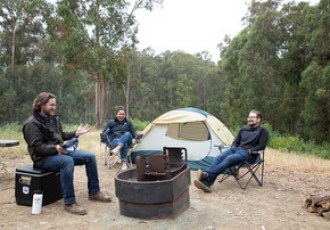BestReviews is reader-supported and may earn an affiliate commission. Details
We recommend these products based on an intensive research process that's designed to cut through the noise and find the top products in this space. Guided by experts, we spend hours looking into the factors that matter, to bring you these selections.

Whether you’re vacationing in Yellowstone National Park, camping along a local trail, or setting up a tent in your backyard, a camping stove provides a way for you to rustle up everything from a reheated can of beans to a medium-rare filet mignon. Indeed, a camping stove adds a touch of fun and comfort to your outdoor adventures!
With a few pots and pans, portable utensils, and some basic foodstuffs, you can cap off a thrilling day of hiking, fishing, or running the rapids with a delicious, home-cooked meal rather than a candy bar and warm soda pop.

If you’re interested in purchasing a camping stove, check out our curated selections.
If you’d like to learn more about camping stoves, you've come to the right place.




















All camping stoves share a common feature: they generate heat that you can use for cooking outdoors.
When perusing the market, however, you’ll find that your product choices run the gamut from one-burner butane stovetops to multi-burner stove/oven combinations with removable racks.
The products in our product list, above, also vary somewhat in their form factor. But all of them offer superior characteristics, which you can read about in our evaluations.
The fuel source you use when cooking on a camping stove depends on the model.
Some stoves require propane or gas to start a fire. Others require a flammable biomass like wood to get the heat going.
If you like to finish cooking quickly, consider a camping stove that requires a propane or gas heat source.

As with any outdoor activity that involves fire, camping stoves should not be used by children.
For those models that rely on gas or propane, the fuel must be handled with extreme care.
It’s also wise to avoid cooking on a camping stove when it’s windy out. Not only will it be difficult to light your fire, but the wind could spread your flames to nearby foliage.
If you inspect the garage of your favorite outdoor enthusiast, chances are you’ll find a camping stove tucked away amidst the other gear.
And it’s a safe bet that the stove will be a bit worn around the edges, because once a camper finds a stove they like, it becomes a best friend — one that can boil water, fry eggs, and put the finishing touches on a freshly caught trout.

To find the camping stove that will be your best friend, here are some guidelines —
Menu: What do you plan to cook on your stove? If someone in your camping group is a foodie or gourmet chef, you’ll probably want that person to have a stove that matches their culinary talent.
At minimum, we recommend a two-burner model. If you like to host seafood boils on the beach, you'll want to opt for a substantial model that can handle the size of your crab pot.
However, if your outdoor menus will be short and simple, a small oven that handles a three-quart pot (or less) should suffice.
At this low price point, you’ll find some smaller units, many of which must be assembled and disassembled before and after each use. The reputable Coleman brand offers several gas-fed, one-burner stoves under $100. At the higher end of the range, you’ll also find some two-burner stoves which may have added features such as a broiler or baking rack.

As you climb above the $100 mark, you’ll find a heftier supply of camping stoves with actual burners for traditional cooking.
Some of these models set up like a folding table on four legs — a bonus for those who prefer the convenience of standing while cooking.
Other creature comforts you might find in this price range include side trays for food prep and a USB port for charging your phone while cooking.

If you’re willing to pay top dollar for a camping stove, you can expect the most deluxe of features: multiple burners, temperature control, fold-out shelves, and more.
A camping stove of this caliber can turn any campsite gathering into a gourmet dining experience.
Follow these safety tips for a positive outdoor cooking experience:
If you’re using a propane stove, be sure the propane tank is kept upright en route to the campsite and stored and in a well-ventilated area.
Put away all leftover food to avoid attracting bears and other large critters.
Let your stove cool thoroughly before packing it up.

Q. What is a “pop can” stove?
A. This is a DIY camping stove that you can make out of a regular beverage can — or even a cat food can — using a knife, scissors, and some other craft supplies. The end result is something like a Sterno burner you might see on a buffet table.
Q. What kind of camping stoves are permitted in the Grand Canyon?
A. Wood or charcoal fires of any type are not allowed. Sterno-type or fossil fuel backpack stoves are permitted.
Q. Can I take my camping stove on an airplane?
A. According to the TSA, camping stoves are allowed as either carry on or checked baggage. The stoves must be empty of fuel with no residual vapors.
Get emails you’ll love.
Learn about the products you’re wondering if you should buy and get advice on using your latest purchases.
